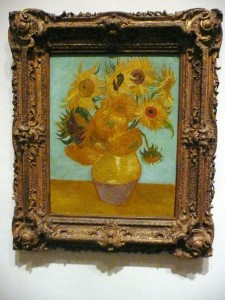Van Gogh’s Ear
by Pinky Kase
Some times strange theories and solutions come to light in the art world. Surely there should be no new evidence or conclusions to be drawn about Vincent van Gogh’s ear. The ear was severed on Christmas Eve in 1888 and presented to a whore named Rachel as a rather macabre early Christmas gift. It was definitely van Gogh’s ear or the better part of it. The authorities had full knowledge of the presenter since he frequently wandered around the town of Arles drunk or messianic or crazy. This was not a time in recent history that understanding and kindness were visited on people whose actions were less than normal. Rachel passed out upon unwrapping her gift and the police went in search of van Gogh, since this was an incident deemed unbearable and indecent by the citizens of Arles. They found him in his house in bed copiously bleeding, semi-conscious and minus the aforementioned ear. The Yellow House, so named because it was painted yellow, was shared by Vincent and his fellow painter Paul Gauguin, who testified that van Gogh had cut off his ear during a fit. Gauguin then sent a telegram to van Gogh’s brother advising him that he should come at once. At this point Gauguin boarded a train to Paris and never returned to Arles.
Theo, Vincent’s brother, came immediately and after a short time in the hospital van Gogh was persuaded to enter an insane asylum in Saint Remy where he produced some of the most significant paintings of his career. There was Starry Night and Cypresses and in 1889 his Self-Portrait with Bandaged Ear and Pipe. One year later van Gogh committed suicide and his ear has managed to increase his fame, serving to recreate him as a love starved genius betrayed and rejected by both Rachel and the world. His art has become reknown as a symbol of one of the greatest efforts of modern art. There is hardly anyone who does not recognize and admire his art. An exhibition of his work delights his audience and brings thousands to museums and exhibitions throughout the world.
That is the way the story was told for over a century, until two reputable German academics, Hans Kaufmann and Rita Wildegans, published their recent book — “Van Gogh’s Ear: Paul Gauguin and the Pact of Silence”. Vincent had a desperate dream of living and working with a community of working artists and Theo practically bribed Gauguin to join Vincent in his fantasy. And so here there were the two of them living together and philosophizing about art. No two artists could be as diametrically opposed in their plans and desires. Vincent obsessed about the warmth of the lush southern Arles, and he wished to abandon all the failures and disappointments he had faced up to this time. He was also hoping to improve both his sex life and his spiritual life; he seemed to imagine Arles as a place of beautiful pious prostitutes. In a way he wanted his paintings to be “spermatic”, explosions of a sexual vitality that he could rarely achieve in life. Now let us compare his desires with those of Gauguin, who by all accounts was tough, brutal, crude, a user and abuser of women. At first the two managed to get along despite their vast differences in opposed personalities. But then reality seems to have set in on the night of December 23rd when Gauguin tore out of the house after a huge quarrel. Van Gogh had been talking him to death about all the things that beleaguered him.
As he walked down the street he hear someone call his name. It was Van Gogh gesturing wildly with a razor in his hand. Here the revisionist story of the German historians takes over. Gauguin was an expert fencer and had his foils with him in Arles. It would have been sensible to carry his sword with him late at night since the town was crime ridden. The historians continue’ “In a heated surge of emotion, he pulls out his rapier and makes several lightning fast fencing moves in Vincent’s direction. He must bring this crazy man to his senses, keep him at a distance…Vincent feels a stinging pain in his left ear…Where is his ear? He sees something lying on the ground. In shock, he picks up the cut off ear and says, ‘you are silent. Indeed I will be, too.’ ”
The argument that they put forward in defense of their theory is that a fencer’s blade can make quick work of the clean slicing of flesh such as an ear while a razor would be a laborious and painful removal of a body part. Mentally disturbed persons are known to mutilate their arms, hands, and legs but not their ears. They cite other fascinating details to support their position, all of which point to a mutual consent of the two men to silence the incident. And where does this lead for the two artists? Gauguin moves on to Tahiti where he continues his symbolist and bright folk color motifs. He also remains that immoral brute that could survive because he was the essential legendary modern painter. And van Gogh? Vincent’s work up to this time had been about people–postmen, children, couples in restaurants. Suddenly people completely disappear from his work when he enters the asylum. It is as if his collaboration with Gauguin was terminated and now he sees only wheat fields filled with black crows, starry nights and conical cypresses heavy with impasto. He uses a palette knife like a weapon pouring huge masses of paint on the canvas. He accepts his isolation accompanied only by his paintings. He maintains only that the belief in his work will one day flower, that there will be a community of readers and viewers who will understand him, that it will come in another world and time. He was so right.



Leave a Reply